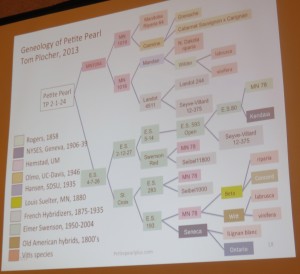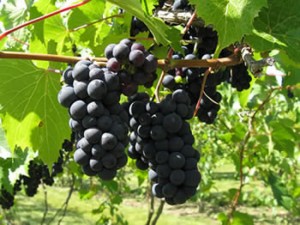Tom Plocher’s New Grapes Are Spreading
University grape breeding programs – like Cornell and Minnesota- grab a lot of attention. But private grape breeders continue to develop many of the grapes that are used to make cold hardy wines.
One of the most prolific and successful creators of cold hardy wine grapes is Tom Plocher. He has been artfully using selective breeding in his vineyard since 1996. Among his mentors is the legendary Wisconsin grape breeder Elmer Swenson.
Plocher spoke recently at the 2016 Craft Beverages Unlimited Conference in St. Charles, Missouri. The 4o degree weather during the Missouri Conference must have felt almost tropical to Plocher, who does most of his grape breeding in Hugo, Minnesota, a northern suburb of St. Paul. He also has multiple test sites throughout Minnesota, including one near Duluth.
The average minimum winter temperature in Hugo is -29 F. Considering -30 F will kill most cold hardy hybrids, one would think Hugo is not a good place to grow grapes. But Plocher said Hugo is a great place to stress test grapes for cold tolerance.
Plocher is a big believer in climate change. Over the course of his life, he finds the changes in the Minnesota climate “shocking.” Studies show that Minnesota has the fastest warming winters in the continental United States, warming at a current rate of 11 F per century.
While Minnesota is warming, the climate remains unpredictable. During the polar vortex of 2013 and early 2014, Plocher said the temperature in Hugo remained below zero for two solid weeks.
Plocher sees local evidence of a weather phenomenon known as “arctic amplification.” This term refers to the increased oscillation of the polar jet stream caused by climate change in polar latitudes. When the polar jet gets kinky, Minnesota weather goes wild.
During March 2012, temperatures climbed to over 80 F in Minneapolis. This historic warmth caused grape vines to break dormancy and bud far too early. Just weeks after the premature summer temperatures, the temperature dropped to 5 F.
This climatic roller coaster ride was a death trip for grapes and other plants. Water started to move up the trunks of grape vines during the late winter warm spell. Then the water quickly froze, splitting the vine wood.
Plocher said a goal for his breeding program is to develop grapes for the rapidly changing northern climate. Petite Pearl and Crimson Pearl- both red wine grapes- are the result of the same 1996 cross. A third grape, Verona, is the result of a 1997 cross. The goal for all three grapes is to hold dormancy and delay bud break. One the criticisms of the newer University of Minnesota cultivars is that they break dormancy early, leaving the tender buds susceptible to spring frost.
Petite Pearl looks like Touriga Nacional, but there’s nothing Portuguese about it. Petite Pearl is “really rugged,” according to Plocher. “Despite some cold damage in Hugo, I think Petite Pearl is rock solid for grape growers south of the Twin Cities,” Plocher told the audience.
On the USDA map, Hugo is shown in zone 4b. But local temperatures are historically much colder than that, Plocher said. In terms of heat accumulation, Hugo is on a line between 2500 and 2600 Degree Days F Base 50. Petite Pearl ripens in that growing degree range, Plocher said.
“Growers ripen Petite Pearl in Fargo, North Dakota, just fine too; but they have to harvest about a week later than I do in Hugo,” Plocher said.
He then responded to a question from the audience about growing Petite Pearl farther south in Missouri. Plocher said the grape might ripen during August, which is not ideal for harvesting or winemaking. The grape also has tight clusters which could create mildew problems in the humid southern Midwest. Southern growers would need to pay attention to spray programs.
Petite Pearl has northern parentage and that’s where it is putting down roots. Both Petite Pearl and Crimson Pearl were the results of 1996 crosses between MN 1094 and ES 4-7-26. MN 1094 is a University of Minnesota hybrid with a genetic background of vinifera, riparia and other species.
Despite the riparia parentage, Petite Pearl still got damaged during the polar vortexes of recent winters. If Petite Pearl does have cold damage, Plocher says the secondary buds are very fruitful.
“This grape has some other nifty growth habits,” Plocher said. “There are virtually no lateral shoots and the internodes are short and well spaced. Petite Pearl grows well on a high wire trellis.”
For Petite Pearl, Plocher suggests a high wire cordon with 4′-5′ spacing between vines. He said four tons per acre is achievable with this approach.
As for the finished wine, it has abundant tannins and works well as a blending component for wines lacking tannins. Plocher said Midwest wineries are using 10%-15% Petite Pearl in combination with other red hybrids.

This genealogy slide from Plocher’s presentation is proof of the complexity of breeding wine grapes. It shows all the grapes that went into creating Petite Pearl.
Low acid levels make Petite Pearl ideal for northern red winemaking. It makes an excellent standalone red varietal wine. The dark red garnet color works to activate three of the five senses instantly. It shows complexity in aroma and flavor that are easily shaped by yeast selection and blending. The finished wine tastes of ripe fruit and has soft mid-mouth tannins. Petite Pearl wine will only improve as more skilled winemakers discover its great potential.
Crimson Pearl is the hardiest of Plocher’s wine grapes. It has Manitoba vitus riparia parentage that allows it to survive in test plots near Duluth, Minnesota. This parentage also conveys a photosensitive trait that causes the vine to harden quickly in the fall as the days grow shorter.
Consumer polling was used to determine the name of Crimson Pearl, but Plocher came up with the name “Verona” himself. This red grape is not as hardy as others, but Plocher thinks Verona is well suited for Iowa, Nebraska and Illinois. Verona has “loads of polyphenols” and the best tannins of the three new Plocher grapes. Plocher said Verona does very well in blind tastings.
Verona, formerly known as T.P. 1-1-34, is a 1997 cross between Troubador (a cross by David Macgregor of Riparia 89 x St Croix) and E.S. 5-4-16, one of Swenson’s unnamed varieties.
Currently, Petite Pearl is the only TTB approved Plocher grape variety. “I still have to petition the other two varieties,” Plocher said.
If you’d like to buy Petite Pearl vines, contact Bevens Creek Vineyard in Minnesota. Northeastern Vine Supply in Vermont also sells Petite Pearl. In Canada, contact A&M Viticulture, St. Paul Abbotsford, Quebec.
Starting in 2017, Inland Desert Nursery in Washington will have certified Petite Pearl vines for sale. Their main focus will be colder niche areas in Oregon, Washington and Idaho that struggle to ripen Cab and Merlot.
Plocher reports that Petite Pearl vines are sold out for 2016. “Both Bevens Creek and Northeastern Vine Supply are taking orders for 2017,” Plocher said. “People who want vines should get on the list.”
And what does Plocher have in the pipeline? Hardier grapes with later bud break that produce high quality wines. He has seedlings that survived the polar vortex and he’s evaluating them carefully. He also has new grapes in development using wild vitus palmate and Russian Golubok as breeding stock. With private breeders like Plocher hard at work, the future is bright for cold hardy wine grapes.



